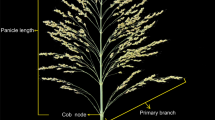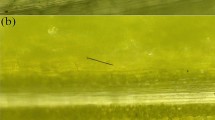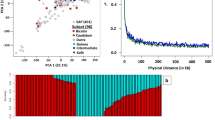Abstract
Plant disease resistance is often a complex, polygenic trait, making its genetic dissection with traditional genome-wide association studies (GWAS) challenging. Grain mold in sorghum, a devastating disease caused by a fungal complex, exemplifies this complexity. We hypothesized that a machine learning (ML)-driven GWAS, employing diverse phenotypic representations from a panel of 306 sorghum accessions, could more effectively unravel the genetic basis of resistance. Phenotypic data, including raw disease scores, a ‘difference phenotype’ (inoculated vs. control), and principal components, were analyzed using Boosted Tree and Bootstrap Forest models, demonstrating strong explanatory power for phenotypic variance when trained on the entire dataset. This ML-GWAS approach confirmed a highly polygenic architecture for grain mold resistance, identifying numerous SNPs across the sorghum genome. Notably, several SNPs were consistently associated with resistance across multiple analytical models and phenotypic representations. These robustly identified SNPs were frequently located near genes with predicted functions integral to plant defense. Gene ontology (GO) analyses of the candidate gene set confirmed enrichment in categories supporting roles in pathogen recognition, DNA repair, and stress response modulation, indicating a multifaceted defense mechanism. This study provides valuable candidate genes for breeding sorghum with enhanced grain mold resistance and offers a refined methodological framework for dissecting complex traits in this crop. The successful application of this ML-based strategy in sorghum suggests its potential utility for studying similar complex traits in other plant species.
This is a preview of subscription content, access via your institution
Access options
Subscribe to this journal
Receive 12 print issues and online access
$259.00 per year
only $21.58 per issue
Buy this article
- Purchase on SpringerLink
- Instant access to full article PDF
Prices may be subject to local taxes which are calculated during checkout






Similar content being viewed by others
Data availability
The complete list of top SNPs, their associated LD blocks, and the complete results of the Gene Ontology (GO) enrichment analysis are available in Supplementary Data 1. All other relevant data that support the findings of this study are available from the corresponding author upon reasonable request.
References
Ackerman A, Wenndt A, Boyles R (2021) The sorghum grain mold disease complex: pathogens, host responses, and the bioactive metabolites at play. Front Plant Sci 12:660171
Ahn E, Hu Z, Perumal R, Prom LK, Odvody G, Upadhyaya HD et al. (2019) Genome wide association analysis of sorghum mini core lines regarding anthracnose, downy mildew, and head smut. PLoS ONE 14:e0216671
Ahn E, Prom LK, Magill C (2023) Multi-trait genome-wide association studies of sorghum bicolor regarding resistance to anthracnose, downy mildew, grain mold and head smut. Pathogens 12:779
Álvarez C, Ángeles Bermúdez M, Romero LC, Gotor C, García I (2012) Cysteine homeostasis plays an essential role in plant immunity. New Phytol 193:165–177
Ashok Kumar A, Reddy BV, Sharma HC, Hash CT, Srinivasa Rao P, Ramaiah B et al. (2011) Recent advances in sorghum genetic enhancement research at ICRISAT. Am J Plant Sci 2:589–600
Ashok Kumar A, Reddy BV, Thakur R, Ramaiah B (2008) Improved sorghum hybrids with grain mold resistance. J SAT Agric Res 6:1–4
Barre A, Bourne Y, Van Damme EJ, Rougé P (2019) Overview of the structure–function relationships of mannose-specific lectins from plants, algae and fungi. Int J Mol Sci 20:254
Basu S, Kumbier K, Brown JB, Yu B (2018) Iterative random forests to discover predictive and stable high-order interactions. Proc Natl Acad Sci USA 115:1943–1948
Boyd RS (2012) Plant defense using toxic inorganic ions: conceptual models of the defensive enhancement and joint effects hypotheses. Plant Sci 195:88–95
Boye C, Nirmalan S, Ranjbaran A, Luca F (2024) Genotype × environment interactions in gene regulation and complex traits. Nat Genet 56:1057–1068
Boyle EA, Li YI, Pritchard JK (2017) An expanded view of complex traits: from polygenic to omnigenic. Cell 169:1177–1186
Brachi B, Morris GP, Borevitz JO (2011) Genome-wide association studies in plants: the missing heritability is in the field. Genome Biol 12:1–8
Bradbury PJ, Zhang Z, Kroon DE, Casstevens TM, Ramdoss Y, Buckler ES (2007) TASSEL: software for association mapping of complex traits in diverse samples. Bioinformatics 23:2633–2635
Breiman L (2001) Random forests. Mach Learn 45:5–32
Burdon JJ, Thrall PH, Ericson L (2006) The current and future dynamics of disease in plant communities. Annu Rev Phytopathol 44:19–39
Bureau A, Dupuis J, Falls K, Lunetta KL, Hayward B, Keith TP et al. (2005) Identifying SNPs predictive of phenotype using random forests. Genet Epidemiol Publ Int Genet Epidemiol Soc 28:171–182
Casa AM, Pressoir G, Brown PJ, Mitchell SE, Rooney WL, Tuinstra MR et al. (2008) Community resources and strategies for association mapping in sorghum. Crop Sci 48:30–40
Chen T (2014) Introduction to boosted trees. Univ Wash Comput Sci 22:14–40
Choi JJ, Klosterman SJ, Hadwiger LA (2001) A comparison of the effects of DNA-damaging agents and biotic elicitors on the induction of plant defense genes, nuclear distortion, and cell death. Plant Physiol 125:752–762
Choudhary AK, Singh S, Khatri N, Gupta R (2022) Hydrogen sulphide: an emerging regulator of plant defence signalling. Plant Biol 24:532–539
Cuevas HE, Fermin-Pérez RA, Prom LK, Cooper EA, Bean S, Rooney WL (2019) Genome-wide association mapping of grain mold resistance in the US sorghum association panel. Plant Genome 12:180070
Cuevas HE, Prom LK (2024) Association analysis of grain mould resistance in a core collection of NPGS Ethiopian sorghum germplasm. Plant Genet Resour 22(4):201–210
Fonseca JP, Lee H-K, Boschiero C, Griffiths M, Lee S, Zhao P et al. (2020) Iron–sulfur cluster protein NITROGEN FIXATION S-LIKE1 and its interactor FRATAXIN function in plant immunity. Plant Physiol 184:1532–1548
Fox D, Yan Z, Ling C, Zhao Y, Lee D-Y, Fukagawa T et al. (2014) The histone-fold complex MHF is remodeled by FANCM to recognize branched DNA and protect genome stability. Cell Res 24:560–575
Frederiksen RA (1986) Compendium of sorghum diseases, American Phytopathological Society (APS Press), St. Paul, MN, USA.
Ge SX, Jung D, Yao R (2020) ShinyGO: a graphical gene-set enrichment tool for animals and plants. Bioinformatics 36:2628–2629
Gonzalez R, Phillips R, Saloni D, Jameel H, Abt R, Pirraglia A et al (2011) Biomass to energy in the Southern United States: supply chain and delivered cost. BioResources 6(3):2954–2976.
Goodstein DM, Shu S, Howson R, Neupane R, Hayes RD, Fazo J et al. (2012) Phytozome: a comparative platform for green plant genomics. Nucleic Acids Res 40:D1178–D1186.
Gould SJ (2010) The panda’s thumb: more reflections in natural history. WW Norton & Company.
Hoggart CJ, Whittaker JC, De Iorio M, Balding DJ (2008) Simultaneous analysis of all SNPs in genome-wide and re-sequencing association studies. PLoS Genet 4:e1000130
Hwang IS, Hwang BK (2011) The pepper mannose-binding lectin gene CaMBL1 is required to regulate cell death and defense responses to microbial pathogens. Plant Physiol 155:447–463
Isakeit T, Collins S, Rooney W, Prom L (2008) Reaction of sorghum hybrids to anthracnose, grain mold and grain weathering in Burleson County, Texas, 2007. Plant Disease Management Reports 2
Jones DA, Jones JD (1997) The role of leucine-rich repeat proteins in plant defences. : Adv Bot Res 24:89–167.
Klimberg R (2023) Fundamentals of predictive analytics with JMP. Sas institute
Korte A, Farlow A (2013) The advantages and limitations of trait analysis with GWAS: a review. Plant Methods 9:1–9
Leslie JF, Zeller KA, Lamprecht SC, Rheeder JP, Marasas WF (2005) Toxicity, pathogenicity, and genetic differentiation of five species of Fusarium from sorghum and millet. Phytopathology 95:275–283
Li X, Guo T, Wang J, Bekele WA, Sukumaran S, Vanous AE et al. (2021) An integrated framework reinstating the environmental dimension for GWAS and genomic selection in crops. Mol Plant 14:874–887
Liu Q, Chen C, Zhang Y, Hu Z (2011) Feature selection for support vector machines with RBF kernel. Artif Intell Rev 36:99–115
Lynch, M, Walsh, B, 1998. Genetics and analysis of quantitative traits. Sinauer, Sunderland, MA
Mackay TF, Stone EA, Ayroles JF (2009) The genetics of quantitative traits: challenges and prospects. Nat Rev Genet 10:565–577
Maillard J-C, Gonzalez J-P (2006) Biodiversity and emerging diseases. Ann N Y Acad Sci 1081:1–16
Manual AB (2013) An introduction to statistical learning with applications in R
Moormann J, Heinemann B, Angermann C, Koprivova A, Armbruster U, Kopriva S et al. (2025). Cysteine Signalling in Plant Pathogen Response. Plant Cell Environ.
Morris GP, Ramu P, Deshpande SP, Hash CT, Shah T, Upadhyaya HD et al. (2013) Population genomic and genome-wide association studies of agroclimatic traits in sorghum. Proc Natl Acad Sci USA 110:453–458
Murtagh F, Legendre P (2014) Ward’s hierarchical agglomerative clustering method: which algorithms implement Ward’s criterion?. J Classif 31:274–295
Nagesh Kumar MV, Ramya V, Govindaraj M, Dandapani A, Maheshwaramma S, Ganapathy KN et al. (2022) India’s rainfed sorghum improvement: Three decades of genetic gain assessment for yield, grain quality, grain mold and shoot fly resistance. Front Plant Sci 13:1056040
Nida H, Girma G, Mekonen M, Lee S, Seyoum A, Dessalegn K et al. (2019) Identification of sorghum grain mold resistance loci through genome wide association mapping. J Cereal Sci 85:295–304
Nürnberger T, Brunner F, Kemmerling B, Piater L (2004) Innate immunity in plants and animals: striking similarities and obvious differences. Immunol Rev 198:249–266
Oliveira RC, Davenport KW, Hovde B, Silva D, Chain PS, Correa B et al. (2017) Draft genome sequence of sorghum grain mold fungus Epicoccum sorghinum, a producer of tenuazonic acid. Genome Announc 5:10–1128
Pandey SP, Somssich IE (2009) The role of WRKY transcription factors in plant immunity. Plant Physiol 150:1648–1655
Pourhoseingholi MA, Baghestani AR, Vahedi M (2012) How to control confounding effects by statistical analysis. Gastroenterol Hepatol Bed Bench 5:79
Prom LK, Ahn E, Magill C (2021) SNPs that identify alleles with highest effect on grain mold ratings after inoculation with Alternaria alternata or with a mixture of Alternaria alternata, Fusarium thapsinum and Curvularia lunata. J Agric Crop Res 9:72–79
Prom LK, Cuevas HE, Ahn E, Isakeit T, Rooney WL, Magill C (2020) Genome-wide association study of grain mold resistance in sorghum association panel as affected by inoculation with Alternaria alternata alone and Alternaria alternata, Fusarium thapsinum, and Curvularia lunata combined. Eur J Plant Pathol 157:783–798
Sharma R, Upadhyaya HD, Manjunatha SV, Rao VP, Thakur RP (2012) Resistance to foliar diseases in a mini-core collection of sorghum germplasm. Plant Dis 96(11):1629–1633
Rigatti SJ (2017) Random forest. J Insur Med 47:31–39
Roy S, Nandi AK (2017) Arabidopsis thaliana methionine sulfoxide reductase B8 influences stress-induced cell death and effector-triggered immunity. Plant Mol Biol 93:109–120
Sager CP, Eriş D, Smieško M, Hevey R, Ernst B (2017) What contributes to an effective mannose recognition domain?. Beilstein J Org Chem 13:2584–2595
Sashidhar R, Ramakrishna Y, Bhat RV (1992) Moulds and mycotoxins in sorghum stored in traditional containers in India. J Stored Prod Res 28:257–260
Schwenk H, Bengio Y (2000) Boosting neural networks. Neural Comput 12:1869–1887
Sham PC, Purcell SM (2014) Statistical power and significance testing in large-scale genetic studies. Nat Rev Genet 15:335–346
Sharma R, Rao V, Upadhyaya H, Reddy VG, Thakur R (2010) Resistance to grain mold and downy mildew in a mini-core collection of sorghum germplasm. Plant Dis 94:439–444
Šimková K, Moreau F, Pawlak P, Vriet C, Baruah A, Alexandre C et al. (2012) Integration of stress-related and reactive oxygen species-mediated signals by Topoisomerase VI in Arabidopsis thaliana. Proc Natl Acad Sci 109:16360–16365
Sirikantaramas S, Yamazaki M, Saito K (2008) Mutations in topoisomerase I as a self-resistance mechanism coevolved with the production of the anticancer alkaloid camptothecin in plants. Proc Natl Acad Sci USA 105:6782–6786
Song Y-Y, Ying L (2015) Decision tree methods: applications for classification and prediction. Shanghai Arch Psychiatry 27:130
Stevens EL, Heckenberg G, Roberson ED, Baugher JD, Downey TJ, Pevsner J (2011) Inference of relationships in population data using identity-by-descent and identity-by-state. PLoS Genet 7:e1002287
Strange RN, Scott PR (2005) Plant disease: a threat to global food security. Annu Rev Phytopathol 43:83–116
Šubr Z, Predajňa L, Šoltys K, Bokor B, Budiš J, Glasa M (2020) Comparative transcriptome analysis of two cucumber cultivars with different sensitivity to cucumber mosaic virus infection. Pathogens 9:145
Tabangin ME, Woo JG, Martin LJ (2009) The effect of minor allele frequency on the likelihood of obtaining false positives. : Springe 3:1–4
Thakur R, Reddy B, Indira S, Rao V, Navi S, Yang X-B, et al (2006) Sorghum grain mold information Bulletin No. 72
Tsuda K, Somssich IE (2015) Transcriptional networks in plant immunity. New Phytol 206:932–947
Upadhyaya HD, Wang Y-H, Sharma R, Sharma S (2013) Identification of genetic markers linked to anthracnose resistance in sorghum using association analysis. Theor Appl Genet 126:1649–1657
Van V (1973) A new evolutionary law. Evol Theory 1:1
Walden H, Deans AJ (2014) The Fanconi anemia DNA repair pathway: structural and functional insights into a complex disorder. Annu Rev Biophys 43:257–278
Wang C, Quadrado M, Mireau H (2024) Temperature-sensitive splicing defects in Arabidopsis mitochondria caused by mutations in the ROOT PRIMORDIUM DEFECTIVE 1 gene. Nucleic Acids Res 52:4575–4587
Yan Z, Delannoy M, Ling C, Daee D, Osman F, Muniandy PA et al. (2010) A histone-fold complex and FANCM form a conserved DNA-remodeling complex to maintain genome stability. Mol Cell 37:865–878
Zohary D (2004) Unconscious selection and the evolution of domesticated plants. Econ Bot 58:5–10
Acknowledgements
This work is supported by the U.S. Department of Agriculture, Agricultural Research Service, In-House Projects No. 8042-21220-258-000-D and 8042-21000-303-000-D. Mention of any trade names or commercial products in this article is solely for the purpose of providing specific information and does not imply recommendation or endorsement by the U.S. Department of Agriculture. USDA is an equal opportunity provider and employer, and all agency services are available without discrimination.
Author information
Authors and Affiliations
Contributions
Conceptualization: EA. Methodology: LKP, SP, DL, JB, VE, SL, JJ, DL. Formal analysis: EA. Validation: EA, SP, DL, JJ, CM. Investigation: LKP, SP. Resources: LKP, JHJ, VE, DL, CM. Writing—Original Draft: EA. Writing—Review & Editing: EA, LKP, SP, DL, JB, VE, SL, JJ, DL, CM. Visualization: EA, LKP, SP, CM. Supervision: EA, CM. Project Administration: EA, CM. Funding Acquisition: EA, LKP, SP, CM.
Corresponding author
Ethics declarations
Competing interests
The authors declare no competing interests.
Ethics approval
Data presented in this manuscript required no ethical approval.
Additional information
Publisher’s note Springer Nature remains neutral with regard to jurisdictional claims in published maps and institutional affiliations.
Associate editor Alison Bentley.
Supplementary information
Rights and permissions
Springer Nature or its licensor (e.g. a society or other partner) holds exclusive rights to this article under a publishing agreement with the author(s) or other rightsholder(s); author self-archiving of the accepted manuscript version of this article is solely governed by the terms of such publishing agreement and applicable law.
About this article
Cite this article
Ahn, E., Prom, L.K., Park, S. et al. Machine learning reveals complex genetics of fungal resistance in sorghum grain mold. Heredity 134, 485–499 (2025). https://doi.org/10.1038/s41437-025-00783-9
Received:
Revised:
Accepted:
Published:
Issue date:
DOI: https://doi.org/10.1038/s41437-025-00783-9



